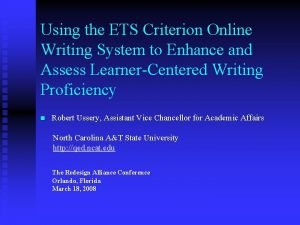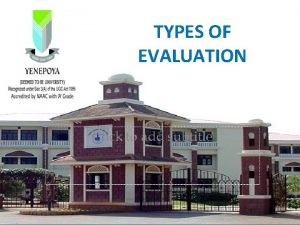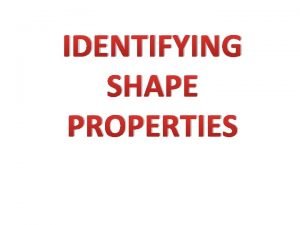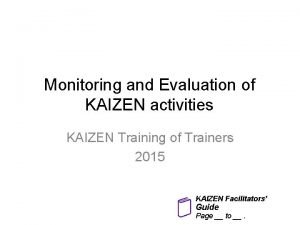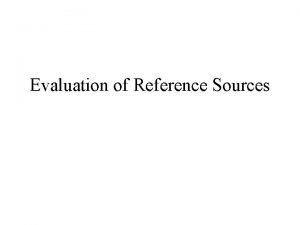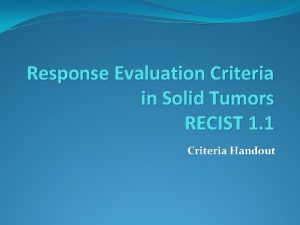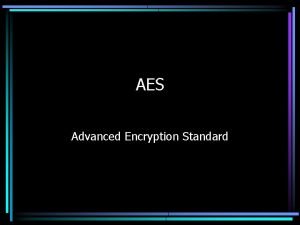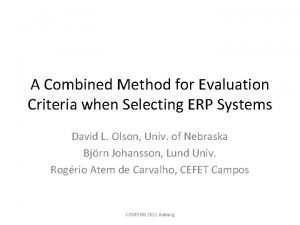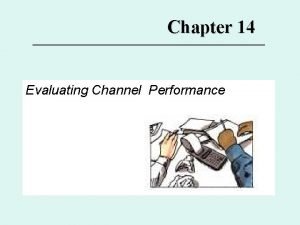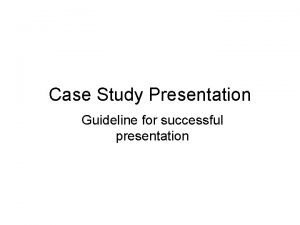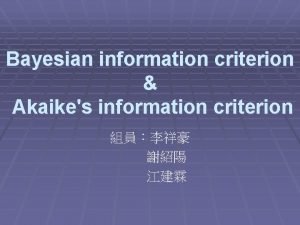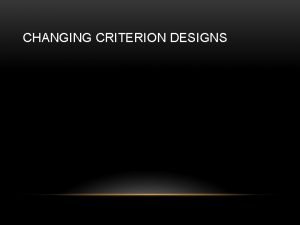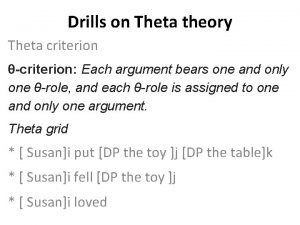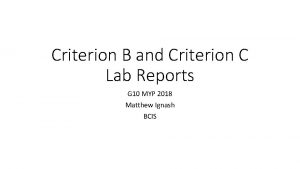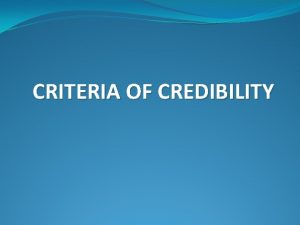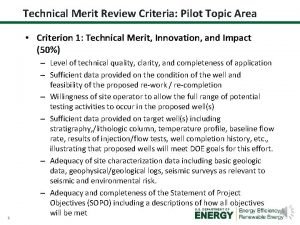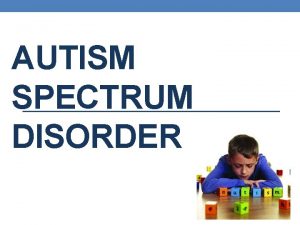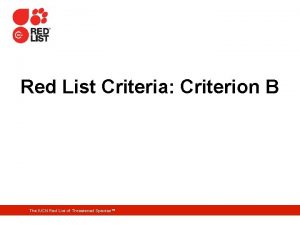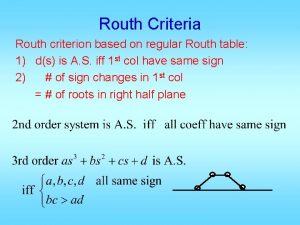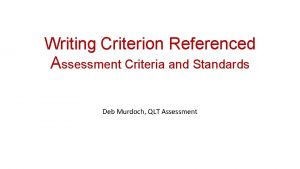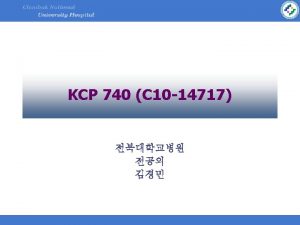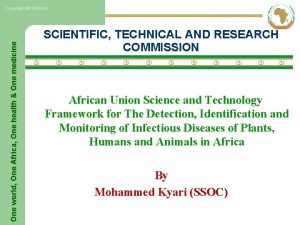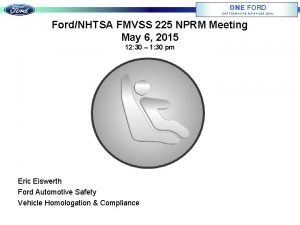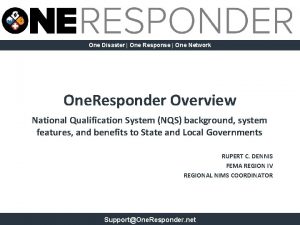Evaluation Criteria Criterion Criteria You have one criterion





























- Slides: 29

Evaluation Criteria

Criterion? Criteria? • • You have one criterion… You have two or more criteria. Like one cow and two cows. One computer, two computers.

Evaluating. . . • Effectiveness = quality of output, accuracy, attractiveness, number of errors etc. How well it achieves its goals. • Efficiency = saving time, money and labour.

Evaluation Criteria • The features you use to judge the quality of something. • E. g. To evaluate a cat, its criteria may be: – Furriness – Friendliness – Mousing ability – Its ability to tell the difference between your shoes and its litter tray.

And • A car’s evaluation criteria may be: – Safety – Fuel consumption – Comfort – Acceleration – Seating capacity

And • A young lady’s criteria for evaluating her new husband may be: – Sense of humour – Income level – Kindness – Ability to kill spiders in the bath And – of course….

Sheer good looks

But • Choose criteria that are relevant and important to the thing being evaluated. • Don’t evaluate a cat on its seating capacity and acceleration. • Don’t evaluate a car on its furriness and mousing ability.

Choosing Criteria • When evaluating any IT product, focus on the criteria that were laid down during the analysis phase of the creation of the product. • During analysis the logical design of the product is formulated. • The logical design lays out the specifications of the finished product: what it should be able to achieve (it does not say how it will be achieved)

For example • When creating a website, the main objectives might be: – Should be interesting to teenagers – Should be quick to load – Should be easy to read • So, when evaluating its success, these are the main factors you would want to evaluate rather than (say) how much it costs to set up.

Typical website effectiveness evaluation criteria • • Accuracy of information Currency (being up-to-date) Loading speed Popularity

Typical website evaluation criteria • Authority (how reputable and respected it is) • Comprehensiveness (thorough coverage of topic) • Depth of coverage • Profitability (costs vs income generation)

Typical website evaluation criteria • Reliability (links work, site is not often down etc) • Security (especially if storing customers’ passwords, credit card info etc) • Uniqueness (offering things found nowhere else) • Objectivity (unbiased in matters of ‘fact’)

Typical website evaluation criteria • Ease of locating desired information • Attractiveness • “Hipness” – looking cool, dope, awesome, alvo, grouse, amped, bad, beautimus , cherry, chim, choice, clutch, crump, etc • Ease of understanding

Typical website evaluation criteria • Accessibility (to people with disabilities) • Entertainment value • Not all these criteria are relevant to - or important to – every site. • Which ones are important depends on the ambitions of the site owners.

Efficiency criteria • How quickly a page loads, a page prints etc • How many man-hours are needed to get the job done • How much the system costs to buy, run, maintain etc

Evaluation methods • To evaluate a criterion, you need a corresponding evaluation method or strategy. • Objectively measure whenever possible; rely on subjective opinions when measurement is not possible.

Criterion Strategy Loading speed Clear cache, load site, use stopwatch to measure loading time in seconds. Authority Look up its Google rating Accuracy Count the number of complaints received about inaccurate data Currency Count the number of page updates made per week

Criterion Strategy Entertainment factor Survey users about how entertaining they found the site to be Ease of use Conduct a questionnaire asking users to report their opinion Reliability Study web server’s error log for 404 (page not found) errors etc. Profitability Study economic records to compare site costs vs online sales.

Evaluation methods • • • interviewing users about their opinions of the system examining error logs to determine the reliability of the system timing its speed when carrying out a typical process load-testing the system to quantify its performance under pressure study its output to judge its readability, accuracy, attractiveness survey customers about the ease of use of the system refer to security logs to see if the system has been subject to successful hacking attempts create error conditions (e. g. pull the plug out) and see if test data is lost or damaged, and how well the system recovers from power outage compare output from the new system with output from the old system and see if it is better Read the log of complaints by users or customers

Remember • Evaluation comes at the very end of a project • Is not the same as testing. • Testing should already have proved the product works. • Evaluation determines how successful the project has been. • Learn lessons to make the next project even more successful e. g…

Criteria for MMOS • • communication of its message readability clarity accessibility (for people with disabilities or special needs, such as weaker language skills)

Criteria for MMOS • • ease of navigation completeness accuracy of information usability / ease of use

Criteria for MMOS • error tolerance – Let users recover from errors without punishing them. – Use “cancel” or “back” buttons – Ask for confirmation before committing users to serious actions such as deleting data, printing hundreds of pages, spending money.

Criteria for MMOS • affordance (i. e. “intuitiveness” rather than “cost” which would be an efficiency criterion). – Affordance is not an easy concept. It refers to the quality of an interface suggesting how it should be used. It includes qualities such as:

Criteria for MMOS • following conventions regarding images and interactions between the user and the solution. – As extreme examples, don’t reverse the behaviour of mouse buttons or put menus into a “new and improved” order you invented yourself.

Criteria for MMOS • using clear, simple, self-explaining words and captions, such as – “Click here for details”, or – “Help” (rather than “User Assistance Centre”)

Criteria for MMOS • Consistency – once the user has learnt the conventions of one page, they can also be understood throughout the whole solution. – Even better, if the conventions don’t need to be learned at all because they comply with global standards (e. g. File menu is on the left, underlining indicates hyperlinks)

Criteria for MMOS • intuitiveness. – It’s obvious that a button or scrollbar with a 3 D effect (for example, shadows and highlights) needs to be clicked or dragged; dropping an object onto a trash icon will delete it; an icon of a chain will create a link. – Use standard metaphors that people can understand without having to learn or think. (Tip: many people hate having to learn or think. Sad, but true. )
 I have chosen you and not rejected you
I have chosen you and not rejected you Criterion online writing evaluation
Criterion online writing evaluation Criterion online writing evaluation service
Criterion online writing evaluation service Criterion and norm referenced assessment
Criterion and norm referenced assessment I have 6 square faces 12 edges and 8 vertices
I have 6 square faces 12 edges and 8 vertices I have a flat face
I have a flat face One god one empire one emperor
One god one empire one emperor Little dog run
Little dog run One king one law one faith
One king one law one faith One god one empire one emperor
One god one empire one emperor One team one plan one goal
One team one plan one goal See one do one teach one
See one do one teach one See one, do one, teach one
See one, do one, teach one Twelfth night speeches
Twelfth night speeches See one do one teach one
See one do one teach one One vision one identity one community
One vision one identity one community One vision one identity one community
One vision one identity one community Wafec
Wafec Vendor digital signage
Vendor digital signage Kaizen evaluation criteria
Kaizen evaluation criteria Criteria for evaluation of reference sources
Criteria for evaluation of reference sources Coa decision brief example
Coa decision brief example Response evaluation criteria in solid tumors (recist)
Response evaluation criteria in solid tumors (recist) Evaluation criteria for aes
Evaluation criteria for aes Software evaluation criteria
Software evaluation criteria Spatial multi criteria evaluation
Spatial multi criteria evaluation Nursing theory evaluation criteria
Nursing theory evaluation criteria Are criteria for evaluating performance of channel members.
Are criteria for evaluating performance of channel members. Case study presentation guidelines
Case study presentation guidelines Trainer evaluation criteria
Trainer evaluation criteria

